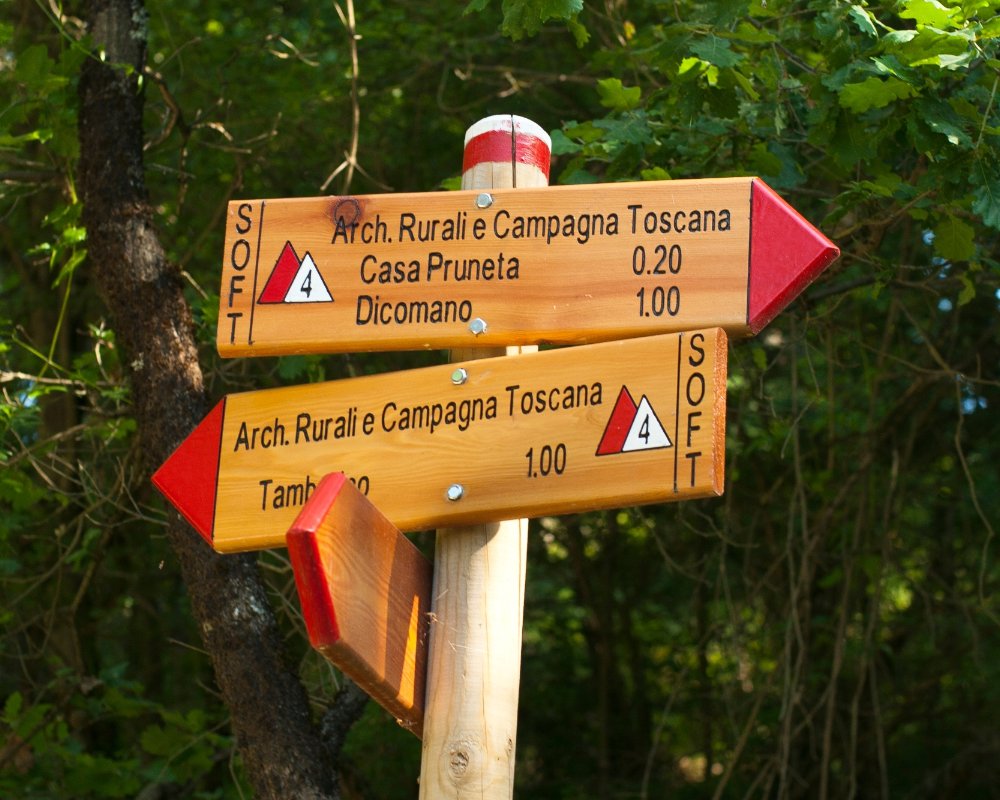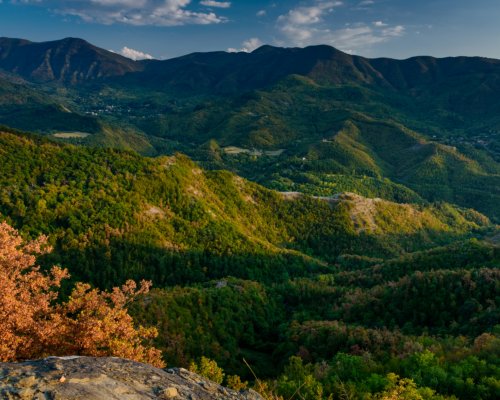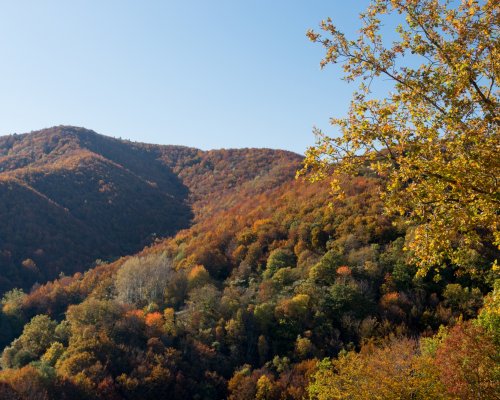Three days from San Godenzo to Florence, through parishes, churches and medieval villages
The Cammino di Dante is a long journey divided into stages, which touch some of the most significant places in the poet's life. In three days of hiking we will explore one of the most important stretches of the Cammino in Tuscan territory, and from our starting point in Val di Sieve we will walk ancient roads and medieval pathways, visit churches and fortresses contemporaneous with the author of the Divine Comedy, and arrive, eventually, in his beloved Florence.
The abbey in San Godenzo will catapult us back into 1302, when exiled White Guelf and Ghibelline factions, usually rivals, united under its roof. Among them was Dante, turned out under a death sentence by the podestà of Florence, Cante Gabrielli da Gubbio. In this little town the exiles formed a pact, which was signed by many notaries and is today preserved in the Florentine state archives.
We will walk to Dicomano along the paths that Dante trod on his flight to Romagna, past parish churches and chestnut trees, through landscapes little altered since his day. We will meet the haunts of his youth, when he spent time at his family's summer residence near Pontassieve, and other places that he does not fail to mention in the Comedy. Eventually we will reach Florence and the heart of his city.
We arrive early in the morning. We visit the Abbey of San Godenzo, the refuge in 1302 of Dante and the other White Guelfs, and the Hermitage of Santa Maria, which is over a thousand years old and surveys Val Montone. We walk in the direction of Castagno D'Andrea, which owes its name to the 15th-century painter Andrea del Castagno. In this little town we can visit his dedicated Virtual Museum, which is found in the Monte Falterona Visitor Centre, one of the means of access to the Parco delle Foreste Casentinesi. The history and the peasant tradition of this place have been shaped by the chestnut wood; we realise this on the walk to Spaliena, surrounded by trees several hundred years old.
Having climbed Monte Campaccio, we descend to the Cappella di Tizzano, home to an ancient terracotta which, according to tradition, was found miraculously by a farmer. From here we proceed along Club Alpino Italiano's path 1A, until reaching the archaeological site of Frascole. The site is still in a stage of excavation but can be visited; and we can observe the layers of settlements from different ages, brought to light by the archaeologists. Beneath the ruins of the 13th-century church of San Martino lie those of an imposing Etruscan building, which belonged to the Velascan dynasty. Leaving the site, we head for the centre of Dicomano, where we spend the night.
We arrive early in the morning. We visit the Abbey of San Godenzo, the refuge in 1302 of Dante and the other White Guelfs, and the Hermitage of Santa Maria, which is over a thousand years old and surveys Val Montone. We walk in the direction of Castagno D'Andrea, which owes its name to the 15th-century painter Andrea del Castagno. In this little town we can visit his dedicated Virtual Museum, which is found in the Monte Falterona Visitor Centre, one of the means of access to the Parco delle Foreste Casentinesi. The history and the peasant tradition of this place have been shaped by the chestnut wood; we realise this on the walk to Spaliena, surrounded by trees several hundred years old.
Having climbed Monte Campaccio, we descend to the Cappella di Tizzano, home to an ancient terracotta which, according to tradition, was found miraculously by a farmer. From here we proceed along Club Alpino Italiano's path 1A, until reaching the archaeological site of Frascole. The site is still in a stage of excavation but can be visited; and we can observe the layers of settlements from different ages, brought to light by the archaeologists. Beneath the ruins of the 13th-century church of San Martino lie those of an imposing Etruscan building, which belonged to the Velascan dynasty. Leaving the site, we head for the centre of Dicomano, where we spend the night.
In the morning we step out into the centre of Dicomano and visit the Parish Church of Santa Maria, which was documented as early as the 12th century, and inside which we find 14tth and 16th-century paintings. Just outside the town we visit the Oratory of Sant'Onofrio, built at the end of the 1700s and considered one of the great examples of neoclassicism. We can admire the succession of elegant buildings with loggias and arches that sit on square columns, especially Palazzo Dalle Pozze and Palazzo Della Nave in Piazza Buonamici.
We then leave the town and follow the signs of the Cammino di Dante, among olive groves and down stretches of medieval roads, hugging the Sieve river until we get to Montebonello. It greets us with its medieval tower, which once played a vital role in guarding access to Val di Sieve from Val d'Arno. We rejoin the road and arrive at Pontassieve.
In the morning we step out into the centre of Dicomano and visit the Parish Church of Santa Maria, which was documented as early as the 12th century, and inside which we find 14tth and 16th-century paintings. Just outside the town we visit the Oratory of Sant'Onofrio, built at the end of the 1700s and considered one of the great examples of neoclassicism. We can admire the succession of elegant buildings with loggias and arches that sit on square columns, especially Palazzo Dalle Pozze and Palazzo Della Nave in Piazza Buonamici.
We then leave the town and follow the signs of the Cammino di Dante, among olive groves and down stretches of medieval roads, hugging the Sieve river until we get to Montebonello. It greets us with its medieval tower, which once played a vital role in guarding access to Val di Sieve from Val d'Arno. We rejoin the road and arrive at Pontassieve.
In the little hamlet of Pagnolle we can visit a house that still belongs to the Alighieri family and where the young Dante probably spent more than a few summers. Curiously enough, there was another villa close by that belonged to the family of Beatrice, the Portinari; so curious, in fact, that some say that their meeting must have taken place in the old Parish Church of San Miniato, the centre of religious life in the little town. It is worth visiting the Parish Church of Sant'Eustachio and the Church of Santa Maria in Acone, the small town that Dante cites in Paradiso XVI as the place from which the neighbouring Cerchi family originated.
We return to Pontassieve and explore the historic centre. The town crouches under Castel Sant'Angelo, which was built in the 1300s by noble Florentine families, affirming the town's unbreakable connection with the city of the lily. Its name comes from the bridge built over the Sieve in the middle of the 16th century by Cosimo I de' Medici, which remains its symbol even today, with its red brick arches and its Medici coat-of-arms.
Leaving Pontassieve behind us, we continue along the river that flows into the Arno until we arrive at the abbey of Rosano, founded in 780. The path proceeds among olive groves and takes us to S. Prugnano, with a view that opens up over the Florentine valley. We keep going, down to the Lungarno, and from there to the Dante House Museum in Florence, on the via Santa Margherita.
In the little hamlet of Pagnolle we can visit a house that still belongs to the Alighieri family and where the young Dante probably spent more than a few summers. Curiously enough, there was another villa close by that belonged to the family of Beatrice, the Portinari; so curious, in fact, that some say that their meeting must have taken place in the old Parish Church of San Miniato, the centre of religious life in the little town. It is worth visiting the Parish Church of Sant'Eustachio and the Church of Santa Maria in Acone, the small town that Dante cites in Paradiso XVI as the place from which the neighbouring Cerchi family originated.
We return to Pontassieve and explore the historic centre. The town crouches under Castel Sant'Angelo, which was built in the 1300s by noble Florentine families, affirming the town's unbreakable connection with the city of the lily. Its name comes from the bridge built over the Sieve in the middle of the 16th century by Cosimo I de' Medici, which remains its symbol even today, with its red brick arches and its Medici coat-of-arms.
Leaving Pontassieve behind us, we continue along the river that flows into the Arno until we arrive at the abbey of Rosano, founded in 780. The path proceeds among olive groves and takes us to S. Prugnano, with a view that opens up over the Florentine valley. We keep going, down to the Lungarno, and from there to the Dante House Museum in Florence, on the via Santa Margherita.


